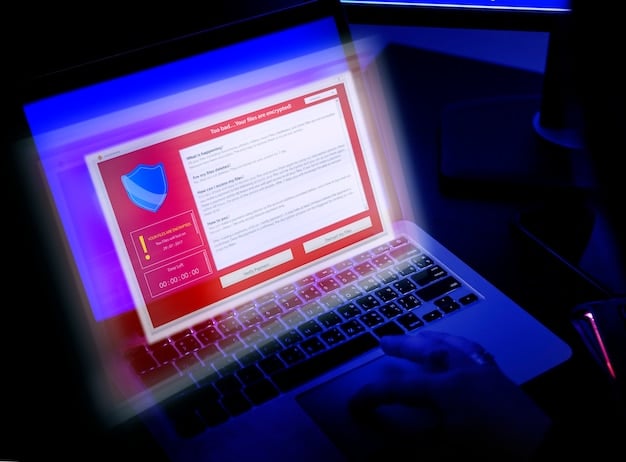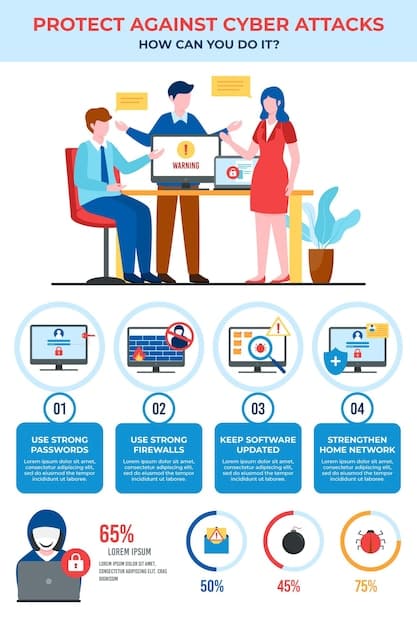Evolving Phishing Attacks: Spot the Latest Tactics & Employee Training

Phishing attacks are evolving at an alarming rate, making it crucial for businesses to stay ahead of the curve by recognizing the latest tactics and implementing effective employee training programs to mitigate risks and protect sensitive data.
In today’s digital landscape, phishing attacks evolving: spot the latest tactics and train your employees is no longer just a recommendation, it’s a necessity. These malicious attempts to steal sensitive information are becoming increasingly sophisticated, making it difficult for even tech-savvy individuals to distinguish them from legitimate communications. Understanding these evolving threats and equipping your workforce with the knowledge to पहचानना and respond appropriately is critical for safeguarding your organization.
Understanding the Evolving Landscape of Phishing Attacks
Phishing attacks are constantly adapting, leveraging new technologies and preying on human psychology to increase their success rates. To effectively combat these threats, it’s essential to understand the current trends and techniques being employed by cybercriminals.
Spear Phishing: Targeting Specific Individuals
Spear phishing attacks target specific individuals within an organization, using personalized information to gain their trust. This approach is much more effective than generic phishing campaigns, as employees are more likely to fall for a message that appears to be from a trusted source.
Whaling: Targeting High-Profile Executives
Whaling attacks are a subset of spear phishing, specifically targeting high-profile executives within an organization. These attacks often involve sophisticated social engineering and can result in significant financial losses or reputational damage.
- Business Email Compromise (BEC): Cybercriminals impersonate executives or vendors to trick employees into transferring funds or divulging sensitive information.
- Ransomware Phishing: Phishing emails are used to deliver ransomware payloads, encrypting critical data and demanding a ransom for its release.
- Credential Harvesting: Phishing attacks are designed to steal login credentials, giving attackers access to sensitive systems and data.
Staying informed about these evolving tactics is the first step in building a strong defense against phishing attacks. Regularly updating your knowledge base and sharing this information with your employees is crucial for maintaining a security-conscious culture.

Latest Phishing Tactics and Techniques
Phishing tactics are becoming increasingly sophisticated, making it harder to distinguish them from legitimate communications. Cybercriminals are constantly innovating their methods to bypass security filters and trick unsuspecting users.
AI-Powered Phishing: Hyper-Personalization at Scale
Artificial intelligence (AI) is revolutionizing phishing attacks by enabling cybercriminals to craft highly personalized and convincing messages at scale. AI algorithms can analyze vast amounts of data to tailor phishing emails to individual recipients, increasing the likelihood of success.
QR Code Phishing (Quishing): A New Delivery Method
QR code phishing, also known as quishing, involves embedding malicious links in QR codes. Attackers distribute these QR codes through various channels, such as emails, flyers, or even stickers in public places. When scanned, the QR code redirects users to a phishing website designed to steal their credentials or install malware.
- Use of Legitimate Branding: Phishers are adept at mimicking the branding and logos of trusted organizations to create a sense of legitimacy.
- Exploitation of Current Events: Phishing campaigns often leverage current events, such as natural disasters or global pandemics, to lure victims with offers of assistance or information.
- Abuse of Cloud Services: Attackers are increasingly using cloud services, such as Google Drive or Dropbox, to host phishing pages and distribute malicious files.
By understanding these latest tactics and techniques, you can better equip your employees to identify and avoid phishing attacks. Regular security awareness training and simulated phishing exercises are essential for reinforcing these lessons.
The Importance of Employee Training in Phishing Prevention
Employee training is a cornerstone of any effective phishing prevention strategy. Even the most advanced security technologies can be circumvented if employees are not vigilant and aware of the risks.
Building a Security-Conscious Culture
Employee training helps foster a security-conscious culture within your organization. By educating employees about the dangers of phishing and empowering them to take proactive steps to protect sensitive information, you can significantly reduce your risk of falling victim to a successful attack.
Reducing Human Error
Human error is a major contributor to successful phishing attacks. Training employees to identify and avoid phishing emails can significantly reduce the likelihood of mistakes. According to industry research, organizations with robust security awareness training programs experience a 70% reduction in successful phishing attacks.
Key Elements of Effective Employee Training:
- Regular Training Sessions: Conduct frequent training sessions to keep employees up-to-date on the latest phishing tactics and techniques.
- Simulated Phishing Exercises: Use simulated phishing exercises to test employees’ ability to identify and report phishing emails in a safe and controlled environment.
- Real-World Examples: Incorporate real-world examples of phishing attacks into your training materials to make the lessons more relatable and memorable.

Designing an Effective Phishing Training Program
A well-designed phishing training program should be tailored to your organization’s specific needs and risk profile. It should be engaging, informative, and regularly updated to reflect the latest threats.
Assessing Your Organization’s Needs
Start by assessing your organization’s specific needs and risk profile. Identify the types of data that are most vulnerable to phishing attacks and the employees who are most likely to be targeted.
Choosing the Right Training Methods
Select training methods that are engaging and effective for your employees. Consider using a combination of online modules, in-person workshops, and simulated phishing exercises.
Key Considerations for Training Program Design:
- Customization: Tailor your training materials to reflect your organization’s specific industry, roles, and security policies.
- Engagement: Use interactive elements, such as quizzes and simulations, to keep employees engaged and motivated.
- Measurement: Track your training program’s effectiveness by measuring metrics such as click-through rates on simulated phishing emails and employee reporting rates.
Measuring the Success of Your Phishing Training Program
Measuring the success of your phishing training program is essential for ensuring that it is effective and achieving its goals. By tracking key metrics, you can identify areas for improvement and demonstrate the value of your investment.
Tracking Key Metrics
Track key metrics such as click-through rates on simulated phishing emails, employee reporting rates, and the number of successful phishing attacks that are prevented. These metrics will provide valuable insights into the effectiveness of your training program.
Regularly Evaluating and Updating Your Program
Regularly evaluate and update your training program to ensure that it remains relevant and effective. Incorporate feedback from employees and stay up-to-date on the latest phishing tactics and techniques.
Key Metrics to Track:
- Click-Through Rate (CTR): The percentage of employees who click on links in simulated phishing emails.
- Reporting Rate: The percentage of employees who report suspected phishing emails to the IT department.
- Training Completion Rate: The percentage of employees who complete the required phishing training modules.
Staying Ahead of the Curve: Continuous Learning and Adaptation
The fight against phishing is an ongoing battle. Cybercriminals are constantly evolving their tactics, so it’s essential to stay ahead of the curve by continuously learning and adapting your defenses.
Staying Informed About the Latest Threats
Stay informed about the latest phishing threats by subscribing to industry newsletters, attending security conferences, and following cybersecurity experts on social media.
Continuously Improving Your Security Posture
Continuously improve your security posture by conducting regular security assessments, implementing new security technologies, and refining your employee training program.
Key Strategies for Continuous Improvement:
- Conduct Regular Security Assessments: Identify vulnerabilities in your systems and processes.
- Implement New Security Technologies: Adopt the latest security solutions to protect against phishing attacks.
- Foster a Culture of Security Awareness: Encourage employees to be vigilant and report suspicious activity.
| Key Point | Brief Description |
|---|---|
| 🎣 Evolving Tactics | Phishing attacks are constantly evolving; stay updated on the latest techniques. |
| 👨🏫 Employee Training | Regularly train employees to recognize and report phishing attempts. |
| 🛡️ Security Culture | Foster a security-conscious culture to minimize human error. |
| 📊 Measure Success | Track key metrics to evaluate the effectiveness of your training. |
Frequently Asked Questions (FAQ)
▼
Common phishing attacks include spear phishing (targeting specific individuals), whaling (targeting executives), and ransomware phishing (delivering ransomware via email).
▼
Look for suspicious sender addresses, grammatical errors, urgent requests, and links that don’t match the stated destination. Verify directly with the sender if unsure.
▼
Do not click any links or open any attachments. Report the email to your IT department immediately. If you did click a link, change your passwords.
▼
Phishing training should be conducted regularly, ideally at least quarterly, to keep employees updated on the latest tactics and reinforce best practices.
▼
Track click-through rates on simulated phishing emails, employee reporting rates of suspicious emails, and the overall reduction in successful phishing attempts.
Conclusion
In conclusion, phishing attacks evolving: spot the latest tactics and train your employees is crucial. By understanding the evolving threat landscape, implementing robust employee training programs, and continuously adapting your defenses, you can significantly reduce your organization’s risk of falling victim to these malicious attacks and protect your valuable data.





